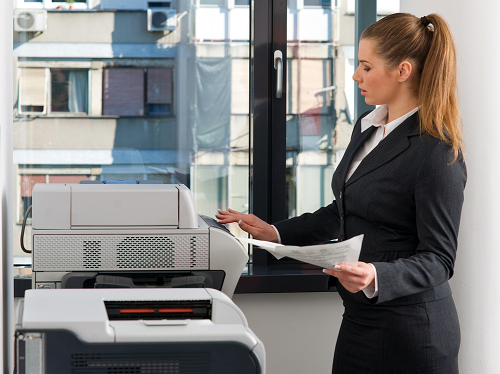“Three Rules of Work: Out of clutter find simplicity. From discord find harmony. In the middle of difficulty lies opportunity.” – Albert Einstein
“It’s not a question of whether we can be sustainable, but whether we choose to be.” – Gary Lawrence
In the larger realm of sustainability and “being green” it may not seem that one workplace can have that much impact or contribute any significant benefit. However, as trite as it may sound, millions of seemingly insignificant “drops” can make an ocean.
One office by itself will not turn the tide of profligate waste of resources, but many of them together certainly will. And that is the real goal of pursuing “green” work practices, which include office printing.
Secondary Benefits of “Green” Office Printing
 From a strictly business profitability standpoint there would be little incentive to pursue green practices if it were a fiscal net loss for a company. Good intentions may carry some initiatives for a while, but if a business is simply becoming less cost-effective and losing money because of them, they won’t last.
From a strictly business profitability standpoint there would be little incentive to pursue green practices if it were a fiscal net loss for a company. Good intentions may carry some initiatives for a while, but if a business is simply becoming less cost-effective and losing money because of them, they won’t last.
In other words, if striving for sustainability isn’t financially sustainable, businesses won’t pursue it.
However, the good news is that smart green practices also add to the bottom line. Which, in turn, supports a company’s goal of being sustainable while contributing to the larger effort of global sustainability.
But how does that work, you might ask?
First, let’s look at some tips for essential green office printing practices in order to get to that.
Better Office Printing for a Better Planet
Paper is the foundation of office printing. Yes, there is also toner, ink and even thermal imaging involved, but it all ends up on paper ultimately. And for most people, paper is the biggest problem when dealing with waste. But there’s good news here.
According to one website,
“Paper is a true renewable resource. Each year, more trees are planted than are harvested to help sustain the supply of wood and pulp for the paper industry.
Knowing a few key facts can help you print comfortably:
- Most paper in North America is made from sawmill residues and recovered paper.
- Paper can be recycled up to seven times before the fibers become too short and weak and break down.
- In 2013, 50 million tons (or 63.5% of the paper used in the United States) was recovered for recycling.
- More corrugated packaging is recovered for recycling than any other packaging material, according to the U.S. Environmental Protection Agency.
- In 2015, the United States recovered enough paper for recycling to fill 125 Empire State buildings.”
Of course, this means establishing a very “strict” and comprehensive waste paper recovery process in your office or place of business. If the bulk of your waste paper ends up in the trash and is not sent off to be recycled, the process is broken.
Reducing the overall use of paper and printing is an admirable and positive goal, but attaining a state of being a “paperless office” probably is not. That’s not only difficult and likely impossible, it also has some serious practical drawbacks.
The more balanced approach is to simply reduce printing and paper use to a practical sustainable level and ensure that the paper is properly recycled when disposed of.
And there are a number of ways you can make your office printing practices “greener” as well:
- Print only what you need
- Use on-demand printing to reduce waste
- Print fewer pages whenever possible
- Use document sizes that reduce waste
- Create pieces that serve multiple purposes
- Make use of self-mailers
- Print pieces smaller or in draft mode
As you can see from these ideas, implementing a more sustainable office printing environment at work requires planning and oversight. It would be fair to say that what are often “suggestions” or “recommendations” from management could easily be established policies instead.
A few more tips for green office printing might include the following:
- Replace your stand-alone devices such as printers, copiers, and fax machines with a single, all-in-one unit to save on space, energy costs and resources
- Print on both sides of the page using the duplex option, narrow margins, and eliminate cover sheets to the paper used
- Use recycled paper containing at least 30% post consumer fiber content
- Implement a recycling program in your office
- Utilize electronic and digital communications tools over paper wherever possible
- Go with a Managed Print Solution that helps monitor and control usage and costs
Going Green Can Save You “Green”
The more obvious cost-savings benefits of implementing gree office printing practices are the reduction of paper and toner cartridge supplies. Paper has never been “cheap” and toner and ink cartridges are where manufacturers traditionally make the bulk of their profits. So the less you use, the less you have to buy.
Related to this is the extended working life of your printers that can result from reduced usage. It stands to reason that if machine “A” is used, say, 25 percent less over the same period of time than an equivalent machine “B”, that machine A should function 25 percent longer.
While the real-world results of this scenario may vary, extending the useful life of your printers is a money-savings benefit nonetheless.
On an even wider scope of savings, ordering less supplies less often means less delivery transportation used, less shipping packaging used, and less delivery trips required. In addition, there is less storage space needed for supplies, and less recycling to be disposed of, and so on.
The bottom line is that green office printing practices benefit the “bottom line.”



